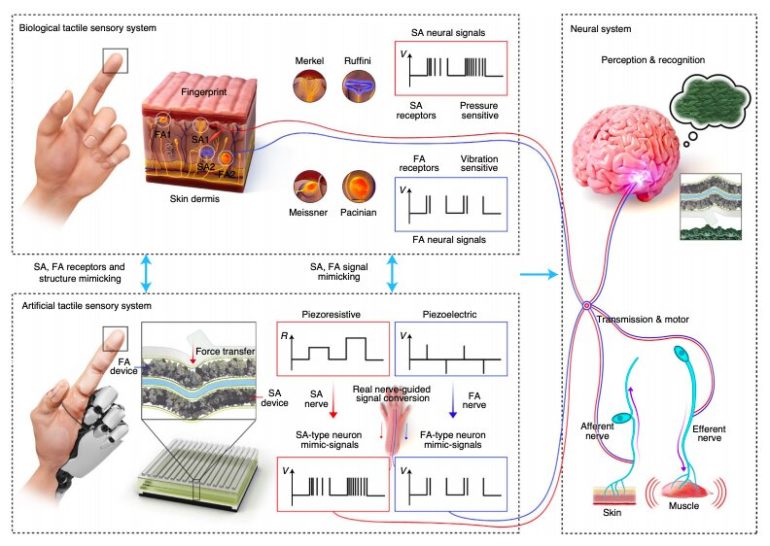Over the past few decades, roboticists and computer scientists have developed artificial systems that replicate biological functions and human abilities in increasingly realistic ways. This includes artificial intelligence systems, as well as sensors that can capture various types of sensory data.
When trying to understand properties of objects and how to grasp them or handle them, humans often rely on their sense of touch. Artificial sensing systems that replicate human touch can thus be of great value, as they could enable the development of better performing and more responsive robots or prosthetic limbs.
Researchers at Sungkyunkwan University and Hanyang University in South Korea have recently created an artificial tactile sensing system that mimics the way in which humans recognize objects in their surroundings via their sense of touch. This system, presented in a paper published in Nature Electronics, uses sensors to capture data associated with the tactile properties of objects.
“We report an artificial neural tactile skin system that mimics the human tactile recognition process using particle-based polymer composite sensors and a signal-converting system,” Sungwoo Chun and his colleagues wrote in their paper.
Biological sensory systems convert tactile stimuli into action potentials through a process known as somatosensory transduction. Subsequently, they transmit these signals to the brain via afferent nerves.
To emulate the human tactile system, the artificial neural tactile skin created by Chun and his colleagues utilizes sensors that respond to pressure and vibration, replicating the function of slow adaptive and fast adaptive mechanoreceptors in the human skin. The data they collect resembles information gathered by human sensory neurons; thus they ultimately produce signals that look like human tactile nerve signals.
The system created by the researchers is made up of T-skin films with conductive piezoresistive and piezoelectric particles arranged in an elastic polymer matrix. The films are ultrathin (-2) and adhesive, thus they highly resemble real human skin.
To evaluate their artificial skin system and prove that it can be integrated within real biological systems, the researchers evaluated it in a series of experiments on mice. These experiments included an ex vivo transmission test in an afferent nerve and an in vivo muscle response test through the stimulation of an efferent nerve. The results of both these experiments were very promising, confirming the possibility of integrating the system within real biological systems.
“We show in an ex vivo test that undistorted transmission of the output signals through an afferent tactile mouse nerve fiber is possible, and in an in vivo test that the signals can stimulate a rat motor nerve to induce the contraction of a hindlimb muscle,” Chun and his colleagues explained in their paper.
In addition to testing their artificial skin by integrating it with real biological systems, the researchers evaluated its ability to analyze and recognize the texture of surfaces. To do this, they laminated artificial ridges that mimic the structure of a human fingertip on their T-skin device. They found that this system could sense complex textural patterns. In addition, the team combined it with a deep learning technique that can classify surface structures, achieving a remarkable texture classification accuracy of 99.1%.
“We use our tactile sensing system to develop an artificial finger that can learn to classify fine and complex textures by integrating the sensor signals with a deep learning technique,” the researchers explained in their paper. “The approach can also be used to predict unknown textures on the basis of the trained model.”
In the future, the artificial tactile sensing system developed by this team of researchers could be integrated with existing or newly developed robotic systems to replicate the human sense of touch. This could significantly improve their performance on tasks that involve touching, grasping and manipulating objects.
A tactile sensing foot to increase the stability of legged robots
More information:
Sungwoo Chun et al, An artificial neural tactile sensing system, Nature Electronics (2021). DOI: 10.1038/s41928-021-00585-x
2021 Science X Network
Citation:
Researchers create an artificial tactile skin that mimics human tactile recognition processes (2021, June 24)
retrieved 27 June 2021
from https://techxplore.com/news/2021-06-artificial-tactile-skin-mimics-human.html
This document is subject to copyright. Apart from any fair dealing for the purpose of private study or research, no
part may be reproduced without the written permission. The content is provided for information purposes only.



